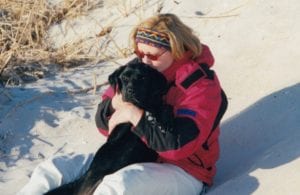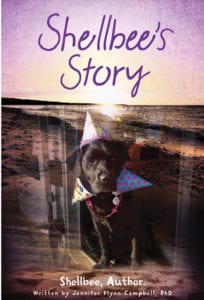Book Review: ‘Shellbee’s Story’
Reviewed by Jeffrey Sanzel
“Hi, it’s me – Shellbee!” Thus begins “Shellbee’s Story,” a tale of a dog (no pun intended) as told by the dog and “recorded” by her “Mommy,” Port Jefferson resident Jennifer Flynn-Campbell. “My story,” continues Shellbee in the first lines, “has been put into words so humans see the world through my eyes, hear the sounds of emotions, and come to understand the purpose behind the adventures of my life.”
Related in a series of almost three dozen letters, Shellbee tells her own story from pup to forever home and beyond. It is funny and touching, clever and honest. In this unusual journey, Flynn-Campbell has chosen to endow the black Lab with extraordinary insight; by the end, she has artfully convinced us that it is Shellbee relating her life’s story.

The book — a hybrid of memoir and fiction and something all its own — is not just for dog lovers but for anyone who has ever been touched by a pet (and, this would most likely encompass just about everyone). Shellbee makes us reflect on ourselves as keepers of these innocent souls — the pleasures and the joys of companionship but also the deeper responsibility. It is about unconditional love on both sides or, in Shellbee’s words, it is “the story of my heartfelt love festival on earth.”
From the get-go, the “Hi, it’s me — Shellbee” that opens each letter captures the voice we imagine our canine companions to have. It celebrates the “it’s-me-it’s-you-I’m-so-glad-your-here” enthusiasm that dogs project.
We are treated to her earliest memories and the routines that root her life. Everything — from parties to pools and canoeing on the lake to staying in hotels — is described in childlike wonderment and appreciation. Shellbee compares country life with city living and ponders with puzzlement her first snow. She vividly relates the terror of getting lost and the relief of being found.
And, of course, at the heart of her thoughts is food, food and food. Food, needless to say, is the focus and center of Shellbee’s life, but it is presented in a manner both humorous and believable. (Even the success of a wedding is measured by how much food is dropped on the ground.)
The Labrador retriever details her training (most notably under the person she refers to as “Dogman”). She does have concern that she wants to maintain her individuality and not become a “Stepford Dog” (which she most certainly does not). She frames the “training” as “companion connection” and “obedience” as “comfort connection.” Shellbee (Flynn-Campbell) has clear ideas about how dogs should live and be educated. She even does work as a therapy dog, here described from her appropriately simple perspective.

Shellbee imparts her responses to all of the creatures she comes across — both human and animal, viewing them as one world — all her “littermates.” She even assigns humans to different dog breeds, categorizing them on looks and personality including a hilarious description of her first visit to Santa: “The first time I saw him I was creeped out: a big, fluffy, hairy-faced human yelping, ‘Ho Ho Ho!’” It is an accurate assessment from an outside point of view.
Shellbee also likes galleries because she has “plenty of room to wag [her] tail while viewing the artwork.”
Flynn-Campbell also introduces some interesting references to studies that have been done — most notably about “declarative memories” and how and why dogs remember the people with whom they’ve crossed paths. In addition, she writes about scientist Rupert Sheldrake’s work on “morphic resonance,” which explains how dogs are aware when their people are coming home. These small digressions further enhance an overall perspective on what it is to have these dogs so present in our lives.
The book deals with serious health issues — both of Shellbee’s as well as both of her human parents. How they support each other in these difficult times is related in tender and touching passages, showing the pain and emotional confusion, and the pure happiness of being reunited. Furthermore, the important topic of animal abuse and the responsibility we have to end it, is highlighted briefly but pointedly: “Humans put a lot of work into helping heal animals who have been hurt on earth.” It is a statement, but, more importantly, a reminder.
There are many photos of Shellbee with her family in various places. They are not portraits but snapshots that capture her in all her day-to-day adventures. Credited to Ariana Boroumand, they make a welcome addition to the narrative.
Shellbee continually comes back to the fact that love will conquer all. Ultimately, it comes down to family. “Knowing you can trust someone is a wonderful feeling.” The book builds to a powerful and inevitable conclusion. While you know it is coming, you cannot help but be moved. Shades of the Rainbow Bridge and spiritual connections are present but are neither saccharine nor maudlin: They are a celebration of all Shellbee was. The ending is one that transmutes grief to hope, loss to recovery.
In the final letter, the sole written by the humans, there is genuine expression of complete appreciation: “Your presence in our lives enriched us in ways that only Shellbee Ann Campbell’s unique soul could. You found a way to break through the struggles we face as humans. Somehow, you always knew just the right thing to do to bring smiles and comfort to everyone you met. Your gift to make tears stop flowing and erase fears from hearts seemed to come naturally to you. You faced each day with effortless happiness, excited for any and all possibilities.”
“Shellbee’s Story” gives a true and poignant meaning to “a dog’s life.”
“Shellbee’s Story” has been featured in Modern Dog magazine as one of its picks for Best Reads and is available online at Amazon and Barnes & Noble. Shellbee posthumously appears weekly in her own blog: www.doggyletters.com and has a popular Twitter account, Facebook page as well as an Instagram account.







